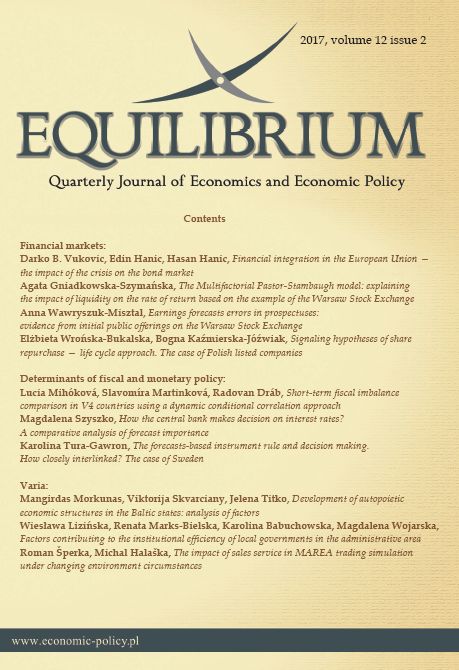HOW THE CENTRAL BANK MAKES DECISION ON INTEREST RATES? A COMPARATIVE ANALYSIS OF FORECAST IMPORTANCE
HOW THE CENTRAL BANK MAKES DECISION ON INTEREST RATES? A COMPARATIVE ANALYSIS OF FORECAST IMPORTANCE
Author(s): Magdalena SzyszkoSubject(s): Economy, National Economy
Published by: Instytut Badań Gospodarczych
Keywords: central bank; inflation forecast; inflation forecast targeting; decision-making
Summary/Abstract: Research background: Most of the modern central banks (CBs) acknowledge the role of economic agents’ expectations in monetary policy. To shape these expectations and to over-come the lags occurrence, CBs produce and reveal macroeconomic forecast and declare that it is the input into their deliberations and monetary policy adjustments. This is how central banks implement inflation forecast targeting. The formal assessments of actual forecast importance in central banks’ decisions is not presented in the literature — to the best author’s knowledge. Purpose of the article: The paper is of methodological nature. It presents the index that compares inflation forecast importance in the central banks decisions. The elaboration of such index is the main goal of the paper. The index is tested empirically for Czechia and Sweden. Methods: Comparably to other research presenting the tools that approximate some qualitative variables, the methodological part of the paper offers the description of the factors covered by the index with their justification and point attribution. The index is suitable to assess CBs decision’s accordance with the forecast produced under constant rate assumption as well as under endogenous interest rates. It is designed to cover low quality data as the time series on the central path of the forecast are not always accessible. In this cases only the relation of the forecast to the inflation target is revealed on the fan charts. Findings & Value added: The index elaboration and its calculation for Czechia and Sweden is presented in the paper. It thus contributes to the literature on ex post assessment of the central bank’s actions. This formalized assessment opens the field for making further con-clusions on inflation forecast targeting implementations and possible impact of the forecast on the economic agents' expectations.
Journal: Equilibrium. Quarterly Journal of Economics and Economic Policy
- Issue Year: 12/2017
- Issue No: 2
- Page Range: 281-294
- Page Count: 14
- Language: English

